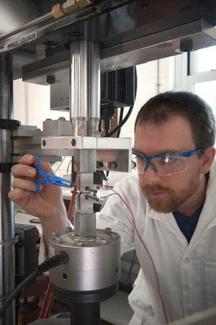Because supercritical CO2 (sCO2) power cycles can improve thermal efficiency and enable energy production from domestic fossil fuels with responsible stewardship of the environment, NETL researchers are aggressively investigating how to maximize the service life of materials in sCO2environments.
sCO2 power cycles operate similarly to other turbine cycles, but they use CO2 – rather than steam – as the working fluid in the turbomachinery. In its supercritical state, CO2 remains liquid-like rather than gas-like and has unique properties for energy generation equipment. For example, turbomachinery that uses sCO2 can be very compact and highly efficient, requiring less compression and enabling better heat exchange.
sCO2 power cycles operate at very high pressures, which means they operate more efficiently so more energy can be created from less fuel and with a reduced cost. Because sCO2power cycles require higher pressures than traditional power generation systems, the physics, chemistry, and components do not behave as they would in conventional systems.
sCO2 cycle environments pose some unique challenges for materials. For example, sCO2 is corrosive and can cause chemical instabilities on the surface of materials. Components may be eroded. Oxidation may cause mechanical instabilities and lead to premature failure. Cost-effective materials are needed that can withstand the combination of mechanical stress, corrosive, and erosive environments for upwards of 100,000 hours of service life.
NETL research is investigating how advanced materials behave in sCO2 environments to better understand how the materials may be optimized for service life. One recent study focused on fatigue – a phenomenon in materials that causes unexpected, costly failures. Fatigue occurs when a component undergoes repeated loading and unloading (fluctuating stresses). This cyclic stress weakens the material and may eventually lead to failure in the form of cracking, producing permanent damage. Because fatigue is a potential limitation, it must be accommodated in the design of sCO2 systems.
To answer questions about how and when fatigue occurs in materials exposed to sCO2 environments, NETL researchers are investigating the fatigue response of nickel superalloys commonly used for advanced energy systems.
Kyle Rozman, Ph.D., a materials researcher at NETL, explained that the research quantified the response of materials to high and low cycle fatigue and provided knowledge about crack growth rates.
“Crack growth is an important design aspect in determining inspection intervals for critical structural parts,” he said. “For components in service, engineers assume crack lengths exist just below detectable limits and use crack growth rates to assess minimum elapsed time for inspection. Information gained from our research will enable engineers to more accurately calculate the minimum life of structural components.”
The research team exposed nickel superalloys Haynes 282 and Inconel 625 to sCO2 at a temperature of 730 degrees Celsius and pressure of 200 bar for 500 hours – conditions representative of what the materials would face in actual working environments. Researchers then compared the results to unexposed specimens, specimens exposed to supercritical water, and specimens exposed to CO2 at 1 bar pressure.
Rozman explained that comparing exposed specimens to unexposed specimens showed how severe the fatigue threshold is, while comparing the results of the material exposed to sCO2 and supercritical water showed how the material behaves relative to typical steam turbine conditions. The material exposed to only 1 bar pressure indicated what effect pressure has on CO2.
Researchers then analyzed the microstructures of the various specimens, with surprising results.
“The precursor to fatigue failure is crack initiation and crack growth,” Rozman said. “We expected the materials exposed to sCO2 to manifest crack growth earlier than the other specimens. The crack growth threshold for these specimens was reduced, but we’re not sure why. Neither corrosion, oxidation, nor microstructural changes seem to have lowered the crack growth threshold.”
The study marks a crucial step forward in enabling a shift from traditional turbine working fluids of high-pressure steam to CO2 that will answer demands for more efficient energy conversion by supplying critical knowledge about how materials will function in this environment.
“Our next step is to quantify residual stresses and their influence on crack growth thresholds,” Rozman said.
Knowledge gleaned from this and other NETL research projects is just one way the Lab is enabling innovations to fuel our nation on domestic energy resources with responsible stewardship of the environment.
Contact:




